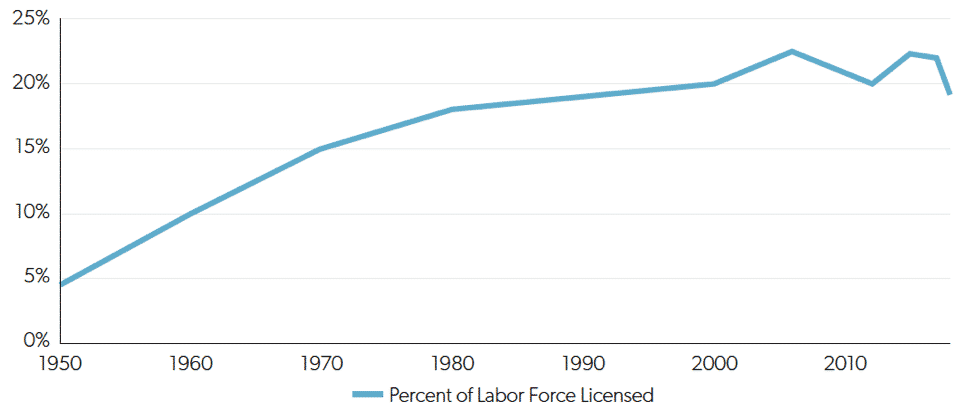Occupational licensing laws are passed by states, setting minimum standards for workers to enter a profession. These required qualifications include education, training, job experience, exams, and fees. Occupational licensing can be thought of as a permission slip from the government to work, because it is illegal to practice without first meeting the requirements and obtaining a credential.
Occupational licenses are contemplated as a form of consumer protection. The motivation for these requirements is to protect the health and safety of consumers, ensuring that they receive high quality services. To accomplish this, licensing laws require that aspiring professionals demonstrate confidence before practicing. Low skilled professionals or charlatans are prevented from being able to practice and harm consumers.
Typically, market competition effectively rewards skilled professionals and drives low skilled ones from the market. But due to the nature of some services, the risk of harm to consumers is great enough that competition could leave many injured before the market process is able to work. In these cases, low quality services pose such a threat to the health and safety that some form of government regulation is appropriate. For example, nearly all professions within healthcare require a license. Low quality healthcare services pose a serious risk to patients, where one mistake can cause permanent injury or death and it is difficult for patients to know the quality of their healthcare provider. Rather than wait for the healthcare provider to make mistakes, they try to ensure quality through licensure.
Proponents of occupational licensing cite two additional benefits. First, licensing laws improve the human capital, or skill, of workers. These more highly skilled professionals are likely to provide higher quality services. Additionally, licensing reduces information asymmetry, or a difference in knowledge about the transaction, between buyers and sellers. It is more difficult to discern the quality of a service than a product before a purchase, so licensing helps consumers know that a professional is qualified. Because consumers are able to have more confidence in the quality of service providers, they are more likely to participate in the market.
The growth of occupational licensing

Occupational licensing has steadily grown to become the most significant labor market regulation in the US. In the 1950s, roughly 5 percent of workers needed a license to work. Now, more than 20 percent of workers do. The growth in licensing can be seen in the figure above. Though much contentious debate surrounds both minimum wage and unionization laws, licensing effects more workers than both of those areas combined.
Some of the increase is due to a growth in the service sector of the economy. But most of it is licensing requirements being extended to a growing list of professions. From 1993 through 2012, on average, states added licensing requirements for 31 professions that required less than a bachelor’s degree. Not only has the number of licensed professions grown, the entry requirements for professions have increased, becoming more difficult over time. This trend can be seen across professions, but it is most prominent in healthcare.
For example, in the 1990s, Physical Therapists required a bachelor’s degree to obtain a license, which increased to a master’s degree by the 2000s, and a doctorate today. The ratcheting up of licensing requirements increases the time and cost of entering a licensed profession, making it more difficult for aspiring professionals. However, it is important to note that current professionals are typically grandfathered in, so they do not need to meet new requirements.
Impact on consumer prices
Because licensing requirements make it more difficult to enter a profession, it restricts the supply of workers. The upfront investment in education and training is a barrier to entry that increases the cost for aspiring workers. Economists find that this has a significant effect. Estimates of the reduction in supply of professionals caused by licensing range from 11 to 27 percent. Additionally, licensed professions grow more slowly, relative to the rest of the economy. This can harm consumers, who receive less convenient services and longer wait times.
It also increases wages for professionals. The estimates vary, but economists tend to find that the licensing premium is around 17 percent, even after accounting for worker characteristics. For some highly skilled professions with substantial licensing requirements, the wage premium is even higher. When higher wages result from professionals becoming more productive or offering higher quality services, both consumers and professionals are made better off. However, the licensing wage premium is primarily a result of the shortage created by occupational licensing, not better services. In effect, licensed professionals increase their wages by making consumers worse off. According to a study performed by economists Morris Kleiner and Evgeny Vorotnikov, the higher wages are passed on to consumers as higher prices—as much as 15 percent higher. In total, Kleiner and Vorotnikov estimate that licensing costs the economy between $183.9 and $197.3 billion due to the higher prices and misallocated resources.
An illustrative example of the effect of occupational licensing on consumers is the “Cadillac Effect.” In a situation where the government mandated only the highest quality, luxury car can be sold, what would happen? Some consumers who were willing to buy a basic economy car, would now buy the more expensive luxury car. But, other consumers would be unable to purchase a car, because the Cadillac exceeds their budget. The average quality of cars would be higher in this world, but many consumers would be left worse off, either by paying more for cars that do not meet their needs or not being able to purchase one.
Licensing works in much the same way, forcing some potential consumers out of the market, and increasing prices for others.
You can help reform occupational regulations. Please sign the petition below.
(function(d, s, id) {
var js, fjs = d.getElementsByTagName(s)[0];
if (d.getElementById(id)) return;
js = d.createElement(s); js.id = id;
js.src = ‘//p2a.co/js/embed/widget/advocacywidget.min.js’;
fjs.parentNode.insertBefore(js, fjs);
}(document, ‘script’, ‘advocacy-actionwidget-code’));

